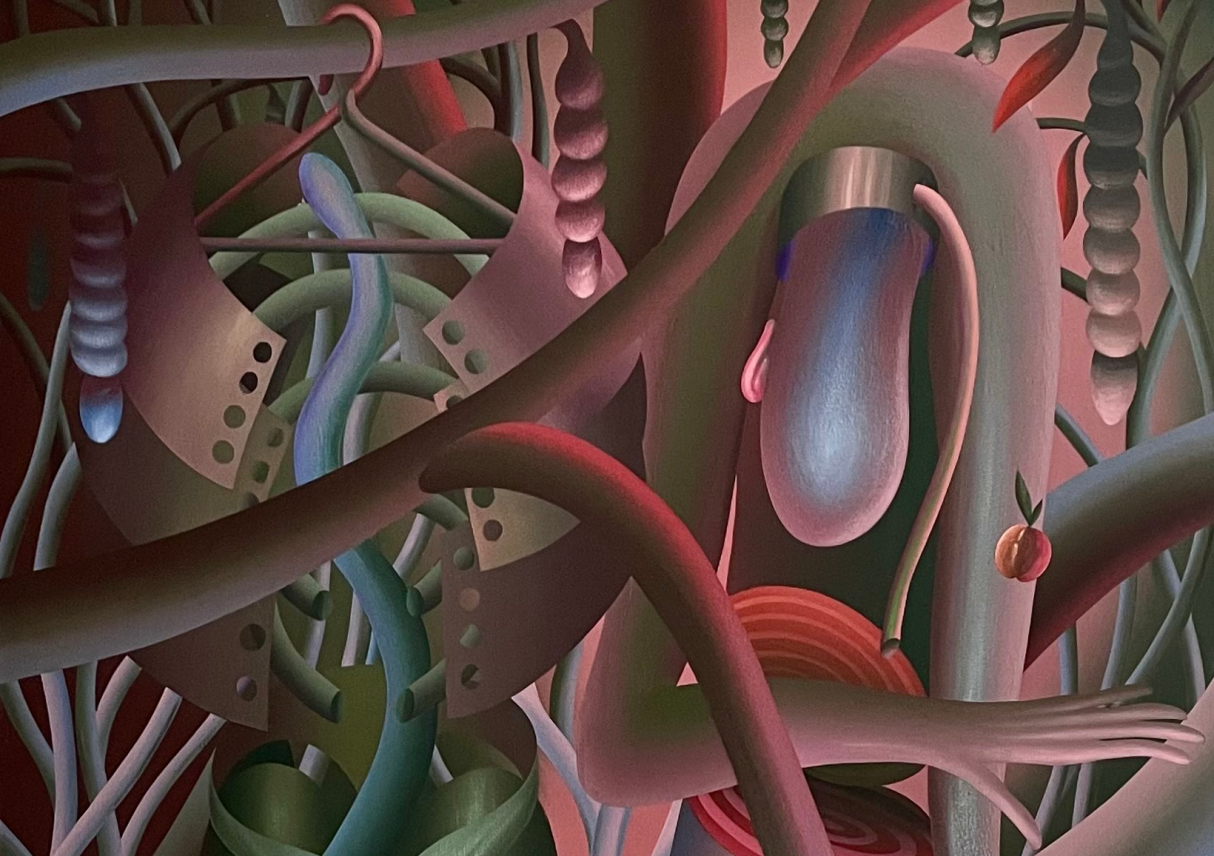Igor Hosnedl: Belladonna harvest
Besides its murderous, medicinal, and renaissance beauty applications, the latter of which gave Atropa belladonna its name, this highly toxic plant native to Central and Eastern Europe has been known to induce hallucinatory dreaming. In folklore it was related to the Devil and witchcraft and believed to endow its users with supernatural powers, like flying. The seductive appearance of this plant combined with its fatal danger, delirious effects, and relation to feminine beauty hints at historic stereotypes and attitudes towards women underpinned by gender myths fueling sanctions against all who deviate from their expected roles. More generally the plant’s symbolism oscillates between toxicity and intoxication, death and transmutation, a good catalyst for themes explored by this exhibition.
The exhibition’s ambience is clean, almost sterile, but nevertheless brings up corporeal associations. Paintings with their saturated palettes appear like surgical incisions in the grayish pink-hued skin of the gallery. The openings reveal interior, quasi theatrical scenes, where the center stage is occupied by strange arrangements of slithery forms, more plant or machine than animal-like. These seem to be propped up on horizontal table-like surfaces, stemming from, propagating and rooting in transparent jars, or forming small indoor gardens. Everything is very clean and airtight – the surfaces, the forms, the cuts. Their tendrils are twisting, turning, growing closer to one another, and intertwining to create a phantasmagoric display. Due to a dim light or a hypnagogic state that marks the passage between realms of dream and wakefulness, the shapes and shadows of your house plants might for a moment suggest the presence of another body.
Our tendency to impose a meaningful interpretation on a nebulous stimulus makes us perceive shapes, figures, and patterns where they may not actually exist. A human face on the surface of an alien planet is one such instance of pareidolia, which might also turn out to be a specific sort of blindness, overlooking possibility for discovery by settling for the comfort of familiar forms. Igor’s paintings do not trade one for the other, but stick with double vision. Yet there is nothing blurry on these pictures. Drawing, which forms the core of Igor’s painting practice, is precise, the edges crisp and clear. Amplified gradients give surfaces a special, artificial sheen, and endow them with otherworldly illumination akin to icons and digital screens.
Igor follows a special recipe when he prepares his own paints. Pigments are treated as potent substances, ground and mixed into ointments which, once rubbed on the canvas, summon vivid, fantastical images. Painting here acts as a medium for accessing altered states of perception where boundaries and divisions between objects, bodies and environment structuring our everyday experience are destabilized, broken down and transformed. Drawing on nature, folklore, mythology, and cultural symbolism these works conjure up memories of iconic images and symbols anchored in our collective imagination only to dissolve and morph back into the thicket. Silhouettes – fingers interlocked, a flower, a lowered head, folded limbs, some leaves, genitals, an apple, a couple – appear and fall apart, and so do their meanings and significance for traditional roles and norms that persist through our culture and politics.
Some forms are cut off, severed, but there is no drama or pain. Some reveal to be empty, lacking substance and linger around as phantom limbs that continue to affect our social and material reality. Some keep on growing. None wither. Like the visitors in Solaris, Stanisław Lem’s novel, who can’t be killed, but keep coming back to haunt the people who dreamed them into existence.
In Igor’s paintings the border between imagination and reality, the self and the other, the inside and the outside, proves to be porous. The strange organic infrastructure from the paintings breaches the frame, its vines appearing in the surrounding space. Familiar topography shifts, it is turned inside-out, and we are pulled into the picture. Our bodies are now just spectral figures among those already flickering in and out of existence in the painted scenes. We are immersed whether we like it or not, Igor’s work seems to tell us, while expressing a holistic vision of the world, where material and symbolic realms emerge from the same larger whole. Immersion, writes Elvia Wilk in Death by Landscape, is not unidirectional, “but rather a type of mutual co-penetration, continuous and constant … A world is forged through co-penetration; immersionis always reciprocal. … Co-penetration is intoxicating. Trying to prevent it is toxic.”
Igor’s works invite us to regard the world and ourselves within it through the lens of metamorphosis. Here, bodies, identities, symbols, and meanings exist as unstable and malleable entities, caught in a perpetual state of shapeshifting— transitioning from one form to another, with their outlines open to be redefined and drawn anew in novel ways. Tendrils are amputated, formations dismembered, but they sprout again, growing, disintegrating and re-forming in new configurations. There is no end to the eternal metamorphic machine. Despite, or as a result of this, the scenes convey a sense of timelessness, calling to mind historical styles of symbolism and metaphysical painting. From an ongoing process of negotiation between figuration and abstraction, new symbolic forms crystallize, imbuing the paintings with a mystical quality, as their meanings remain occult.
